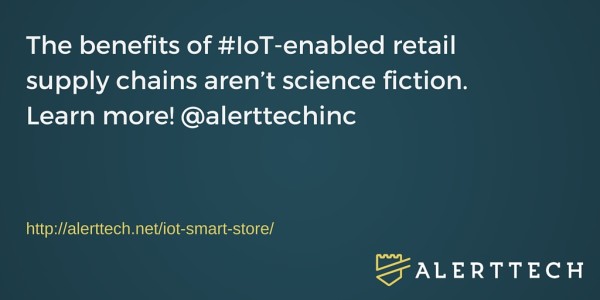We hear a lot about the Internet of Things (IoT) and we have provided definitions and offered suggestions for practical applications for the IoT in a retail setting. But when it comes to seeing how the power of the IoT can apply to everyday business, there is no better example of how it works than a day in the life of an article of clothing in a connected retail supply chain.
A Day in the Life of a Retail Product
To a customer, it’s a shirt on a rack, but for those responsible for all the steps along the supply chain that got it to that rack, that shirt represents the culmination of a long journey. And if the retailer selling that shirt is taking advantage of all that the IoT has to offer, they knew where it was at every step along the way.
When you consider that there are millions of items purchased at millions of stores every minute of every day, you can start to imagine the scope of the retail supply chain. All of the data these processes generate is stored in the cloud, waiting to be accessed by a myriad of interconnected devices by people in many different companies. It’s really quite incredible!
To better understand how the IoT can improve the customer experience, and improve retailers’ bottom lines, let’s track the process that gets a single shirt from the cotton fields to the customer’s closet.
Is the Manufacturer the First Step of the Process?
First, the order for the shirt is made with the manufacturer. The manufacturer knows what raw materials to order based on the quantities requested by the buyer. This brings about an interesting “Chicken or Egg?” question: Is the manufacturer the first point of the supply chain, or does it start with the retailer placing the order? Perhaps the most accurate description is that it’s a continuous cycle, rather than an A to B process.
The sizes and quantities of that order were based on sales history and cross-referenced with data from customer loyalty programs to ensure adequate quantities of each size and style. Every item is easily identified by its unique UPC code, which will be accessed many times before that shirt makes it home with the consumer.
[Tweet “Surprise and Delight #Retail Customers with a Smarter Store @alerttechinc”]
The manufacturers shipped that shirt, along with thousands of others, to the retail distribution center. The shirt, or more accurately the box it shipped in, was scanned by the shipping company transporting to the distribution center. In some cases, it was scanned again by customs officials in multiple countries.
The Journey from the Warehouse to the Salesfloor
Once our shirt was shipped to the store, it was labeled, priced and put on display. If it’s equipped with an RFID tag, the retailer knows whether it’s on a rack in the store or in the stockroom. This is inventory management turned up to 11, and it dramatically reduces shrinkage due to internal errors.
[xyz-ihs snippet=”TOFU2-Retail-Technology-button”]
Connected retailers are testing digitally-enabled shelf signage that will allow for price adjustments at the click of a mouse. Think of how much time will be saved when the process of changing prices for sales events no longer requires manual intervention!
The Customer Experience
The real benefit of an IoT-powered store comes when it enhances the customer’s experience as they pick up that shirt from the shelf. If they don’t see their size, a quick scan from an employee’s hand-held device lets them know if it’s available in the stockroom or at another location.
If the fitting room is connected, another size, color or style is available at the press of a button, and upsell/cross-sell recommendations in the form of complementary pieces are ready in a snap. Loyalty rewards, mobile checkout options and customized product recommendations based on the customers’ purchasing history are seamlessly presented to the customer.
All of this became possible because a retailer was open to all the possibilities of interconnectivity. What started off as a story about a shirt has become a case study for the ways technology can improve the inventory process, much to the relief of retailer and the delight of customers.
Bringing the Benefits Home – The IoT Smart Store
The benefits of IoT-enabled retail supply chains aren’t science fiction. Everything we mentioned here is in use in stores today. Some companies make use of just some of the tracking and technology, and others use it all.
Those putting technology to best use are the ones who work with a proven technology partner who can help extract the right kernels of knowledge from big data to drive sales and enhance retail success.
[xyz-ihs snippet=”BOFU-Demo-CTA”]

